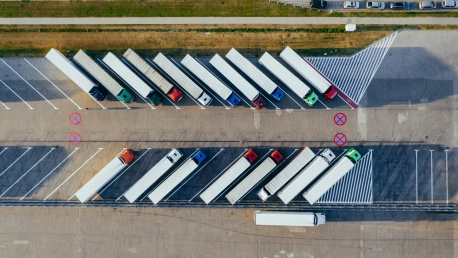The meteoric rise of online shopping and e-commerce over the past decade has not only transformed the retail landscape but has also significantly impacted the commercial vehicle fleet sector. As consumers gravitate towards the convenience of home delivery for everything from groceries to furniture, businesses have had to rapidly expand their delivery capabilities, resulting in an insatiable demand for various delivery vehicles. This article explores how the e-commerce boom has fueled a surging demand for delivery fleets, the prioritization of fleet electrification, the emergence of new business models, the pivotal role of fleet management and maintenance, and the road ahead for fleet management in the face of these changes.
The Surge in Delivery Fleet Demand
E-commerce has seen exponential growth over the past 5-10 years, leading to a significant uptick in the demand for delivery fleets. Retailers and logistics companies are in a competitive race to build their transportation networks to meet escalating consumer expectations. This surge necessitates a considerable increase in light commercial vans, trucks, and last-mile delivery vehicles. Major players like Amazon have responded by scaling their fleets rapidly, ensuring they can meet the demand for fast and reliable delivery services.As e-commerce continues to grow, businesses are compelled to expand their fleet sizes to manage increasing order volumes. The increasing complexity of logistics networks also highlights the need for specialized vehicles capable of handling various types of deliveries, from perishable groceries to large furniture items. This growth presents both opportunities and challenges for fleet managers who must balance expanding their fleets while maintaining operational efficiency. The logistics involved in handling a myriad of delivery types require not only a larger quantity of vehicles but also a diverse range of vehicle specifications to fit every logistical scenario.Moreover, the rise of personalized delivery services presents new logistical challenges. Meeting customer expectations for same-day delivery or specific delivery windows requires optimized routing and real-time fleet tracking. Advanced fleet management software plays a vital role in managing these complexities, offering real-time insights and facilitating smooth operations. By employing sophisticated software solutions, fleet managers can make data-driven decisions that streamline operations and enhance customer satisfaction. These tools can help automate dispatch, track vehicle performance, and predict maintenance needs, ultimately reducing costs and improving efficiency.
Prioritizing Fleet Electrification
With growing pressure from consumers, investors, and regulators, reducing the environmental footprint of delivery fleets has become paramount. Amazon and other industry giants have set ambitious goals for transitioning to electric delivery vans and achieving carbon-neutral operations. Sustainability has become a critical factor in fleet procurement and strategy, with Fleet Advisors Group President Janet Woodcock emphasizing the importance of sustainable practices in modern fleet management. Organizations are recognizing that eco-friendly approaches not only comply with regulations but also enhance brand reputation and customer loyalty.Electric vehicles (EVs) are becoming more viable for commercial applications, altering the total cost of ownership (TCO) equation for delivery fleets. Fleet managers are exploring various alternative fuel and electrification options, including battery-electric, plug-in hybrid, and fuel cell technologies. Each option presents unique benefits and challenges that require careful consideration in the decision-making process. For instance, while battery-electric vehicles offer zero emissions and lower running costs, they require significant investment in charging infrastructure and may have range limitations depending on the delivery route.The transition to electric fleets also necessitates a focus on vehicle connectivity and charging infrastructure. Ensuring that vehicles are adequately charged and maintained becomes a logistical challenge that fleet managers must address. Fleet management software equipped with telematics data can help track vehicle energy consumption, battery health, and charging patterns, contributing to more efficient and sustainable operations. This transition is not just about replacing gasoline engines with batteries; it involves a holistic approach to energy management and route optimization to maximize efficiency and sustainability.
New Business Models and Innovations
The surge in e-commerce delivery has opened new avenues for fleet services, technologies, and business models. Major truck manufacturers such as Daimler and Volvo have established dedicated electric truck divisions, while innovative companies like Rivian, Arrival, and BrightDrop are introducing new electric delivery van models to the market. These advancements are reshaping the traditional landscape of fleet management, offering more sustainable and technologically advanced solutions to meet growing demand. This shift reflects a broader trend towards electrification and digitalization in the industry.Subscription services and transportation-as-a-service platforms, offered by companies like Vehicle Rent and Fleetroot, are disrupting traditional ownership models. These services provide flexibility and efficiency, allowing companies to finance, maintain, and optimize their delivery fleets at scale. This innovation is crucial for businesses seeking to maintain agility in an increasingly competitive market. By reducing the initial costs and commitment associated with vehicle ownership, these models enable companies to adapt quickly to market changes and fluctuating demand.These new business models extend the operational life of fleet vehicles and contribute to the overall efficiency of fleet management. By leveraging transportation-as-a-service, companies can adapt to fluctuating demand without the burden of long-term vehicle ownership. This model also opens opportunities for smaller businesses to access advanced fleet solutions that were previously out of reach. Accessing state-of-the-art technologies and services can level the playing field, allowing smaller players to compete with larger, more established companies on equal footing.
The Role of Fleet Management and Maintenance
Efficient fleet management and maintenance are mission-critical in the rapidly evolving e-commerce landscape. Advanced fleet maintenance management software offers comprehensive visibility into fleet operations, enabling managers to monitor inventory, real-time vehicle status, and preventive maintenance activities. This holistic view helps prevent costly breakdowns and ensures that vehicles remain operational, thus enhancing overall productivity. Comprehensive data analytics provide actionable insights that can lead to better decision-making and optimized resource allocation.Predictive maintenance solutions, powered by telematics data and artificial intelligence/machine learning (AI/ML), are revolutionizing fleet maintenance. These solutions can predict potential vehicle issues and schedule preemptive repairs during routine maintenance windows, reducing unexpected downtimes. This proactive approach extends vehicle life and optimizes fleet performance, which is crucial for high-volume delivery operations. Leveraging data analytics to foresee maintenance needs can significantly reduce operational disruptions and improve bottom lines by keeping fleets in top condition.Regulatory compliance is another essential aspect of effective fleet management. Electronic logging and compliance management tools ensure that delivery fleets adhere to safety regulations, such as hours-of-service rules and vehicle inspection requirements. As companies transition to electric and alternative fuel vehicles, fleet management software integrated with telematics can track energy consumption, battery health, and carbon emissions, facilitating compliance with sustainability goals. Adopting these practices not only ensures legal compliance but also promotes corporate responsibility and environmental stewardship.
The Growing Importance of Maintenance and Repair Providers
The rapid growth of online shopping and e-commerce over the past decade has revolutionized the retail landscape and significantly impacted the commercial vehicle fleet sector. As consumers increasingly prefer the convenience of home delivery for items ranging from groceries to furniture, businesses have been compelled to expand their delivery capabilities. This expansion has led to an insatiable demand for a variety of delivery vehicles. This piece delves into how the e-commerce boom has driven a surge in demand for delivery fleets, the emphasis on fleet electrification, and the rise of new business models. It also examines the crucial role of fleet management and maintenance, and what the future holds for fleet management amid these changes. Moreover, companies are continually striving to adapt and innovate to meet customer expectations and regulatory requirements, ensuring that they stay competitive while minimizing environmental impact. The evolution in this sector indicates a broader shift towards more sustainable and efficient delivery solutions.









